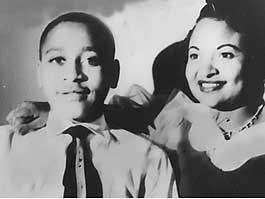The Untold Story of Emmett Louis Till
By Kim Hollis
February 27, 2006
BoxOfficeProphets.com

The Untold Story of Emmett Louis Till illustrates just such a moment in time. As Black History Month draws to a close, it only seems appropriate to highlight this documentary that chronicles the events that led to pivotal revolution in the Civil Rights movement.
Directed by Keith Beauchamp in cooperation with Till's mother, Mamie Till-Mobley, The Untold Story of Emmett Louis Till aims to get the truth of a story in front of the public eye, and does so successfully. The film's centerpiece is a 14-year-old boy named Emmett, a spirited boy from Chicago who goes on a vacation to visit a grand uncle in Mississippi in 1955. Unfortunately for Emmett, he was unaware that social mores in the South were far different than in his hometown. And so it was that when the young black man attempted jocular communication with a white woman, things went terribly, terribly wrong.
Friends and family members describe Emmett's contact with Carolyn Bryant as innocent. He went into the store where she worked to buy some chewing gum, and when he gave her the money to pay for the item, he actually touched her hand. That was his first mistake. Since he was a big jokester, when she came out of the store to get into her car, he whistled at her, an action that would prove fatal to the young man.
Later that week, two men, Carolyn Bryant's husband Roy and his half-brother J.W. Milam, arrived to forcibly remove Emmett from his uncle's home. Despite his uncle's protests that he would simply put Emmett on a train back to Chicago first thing in the morning, the men insisted that the boy would have to be punished. They would whip him a bit and then bring him back home. Emmett never came back. His body was found in a nearby river, and his uncle was only really able to identify him by a ring that he wore.
In spite of efforts by the police to quickly bury the body in Mississippi, Mamie Till-Mobley insisted that the body be returned to her, and won the right to do so literally moments before he was interred. Even more difficult for her was the decision to have his casket open at the funeral despite his extreme disfigurement. Mamie wanted to be sure that no such thing ever happened to a child again.
Bryant and Milam were arrested for murder and kidnapping, but the result of the trial was almost a foregone conclusion. Although the locals seemed to concede that the men had in fact kidnapped and killed Emmett, the notion was that they were somehow justified to do so. Emmett had gone against the "rules" of their society, and he had to be made an example. The men were acquitted of murder, and the grand jury chose to not even deliver a charge for kidnapping. A few months later, they told their entire grisly story to Look Magazine, aware that they were exempt from being re-tried due to the double jeopardy law.
The Untold Story of Emmett Till is frank and honest in the retelling of the circumstances surrounding the boy's death. Interviews with his uncle, cousins and close friends are shown, and a witness to what took place at the time of the murder is also featured. Discussions with Mamie Till-Mobley reveal that she received numerous bomb and death threats telling her to stay away from the courthouse as the trial was about to begin. A photo of Emmett as he appears in his casket is shown - and it is truly devastating.
In the end, though, Emmett was never forgotten. Not only was his murder a huge catalyst and spark for the progression of the Civil Rights movement, but in 2004, the U.S. Department of Justice reopened the case. Unfortunately, Mamie Till-Mobley passed away months before this happened, but Beauchamp remained constantly determined to see justice done.
I believe that this is an important documentary that deserves a wide audience. It's worthy of school study, and to that end, the DVD includes a variety of supplemental materials that are perfectly targeted to teachers. In addition to commentary from the director, there is also a featurette titled "The Impact of the Emmett Till Case in American History and Today" from the Civil Rights Project of Harvard University. There is also a CD-rom with a teaching guide.